-
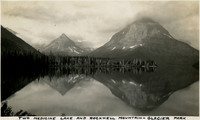 McCarthy Album 10, Photograph 163
McCarthy Album 10, Photograph 163 Caption: "Two Medicine Lake and Rockwell Mountain - Glacier Park," c. 1935.
-
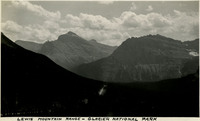 McCarthy Album 10, Photograph 162
McCarthy Album 10, Photograph 162 Caption: "Lewis Mountain Range - Glacier National Park," c. 1935.
-
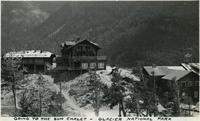 McCarthy Album 10, Photograph 161
McCarthy Album 10, Photograph 161 Caption: "Going to the Sun Chalet - Glacier National Park," c. 1935.
-
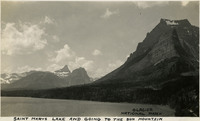 McCarthy Album 10, Photograph 160
McCarthy Album 10, Photograph 160 Caption: "Saint Mary's Lake and going to the Sun Mountain. Glacier National Park," c. 1935.
-
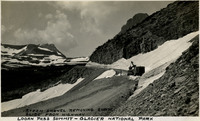 McCarthy Album 10, Photograph 159
McCarthy Album 10, Photograph 159 Caption: "Steam shovel removing snow slide from highway. Logan Pass Summit - Glacier National Park," c. 1935.
-
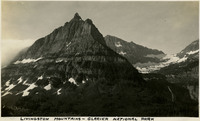 McCarthy Album 10, Photograph 158
McCarthy Album 10, Photograph 158 Caption: "Livingston Mountains - Glacier National Park," c. 1935.
-
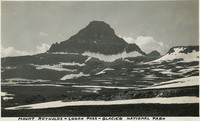 McCarthy Album 10, Photograph 157
McCarthy Album 10, Photograph 157 Caption: "Mount Reynolds - Logan Pass - Glacier National Park," c. 1935.
-
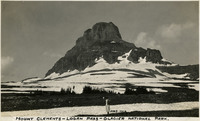 McCarthy Album 10, Photograph 156
McCarthy Album 10, Photograph 156 Caption: "Mount Clements - Logan Pass - Glacier National Park, Mrs. McC.," c. 1935, shows Grace McCarthy in the foreground holding a snowball.
-
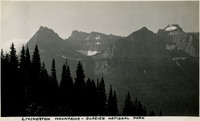 McCarthy Album 10, Photograph 155
McCarthy Album 10, Photograph 155 Caption: "Livingston Mountains - Glacier National Park," c. 1935.
-
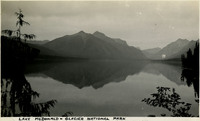 McCarthy Album 10, Photograph 154
McCarthy Album 10, Photograph 154 Caption: "Lake McDonald - Glacier National Park," c. 1935.
-
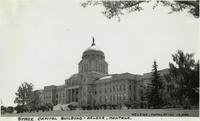 McCarthy Album 10, Photograph 153
McCarthy Album 10, Photograph 153 Caption: "State capitol building - Helena, Montana. Helena, Population 12,000," c. 1935.
-
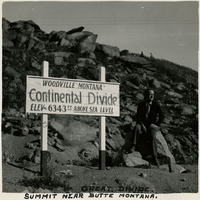 McCarthy Album 10, Photograph 152
McCarthy Album 10, Photograph 152 Caption: "Great Divide. Summit near Butte Montana," c. 1935.
-
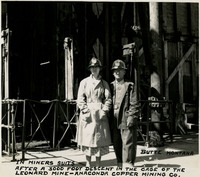 McCarthy Album 10, Photograph 151
McCarthy Album 10, Photograph 151 Caption: "Butte, Montana. In miner's suits after a 3,000 foot descent in the cage of Leonard Mine - Anaconda Copper Mining Co.," c. 1935, shows William and Grace McCarthy in miner's suits and helmets.
-
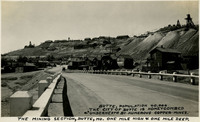 McCarthy Album 10, Photograph 150
McCarthy Album 10, Photograph 150 Caption: "Butte, population 40,000. The city of Butte is honeycombed underneath by numerous copper mines. The mining section, Butte, Mo. one mile high & one mile deep," c. 1935.
-
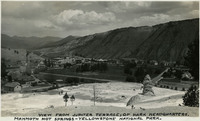 McCarthy Album 10, Photograph 149
McCarthy Album 10, Photograph 149 Caption: "View from Jupiter Terrace, of Park headquarters. Mammoth Hot Springs - Yellowstone National Park," c. 1935.
-
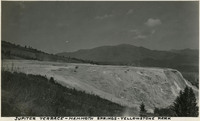 McCarthy Album 10, Photograph 148
McCarthy Album 10, Photograph 148 Caption: "Jupiter Terrace - Mammoth Springs -Yellowstone Park," c. 1935.
-
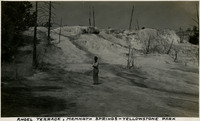 McCarthy Album 10, Photograph 147
McCarthy Album 10, Photograph 147 Caption: "Angel Terrace, Mammoth Springs - Yellowstone Park," c. 1935, shows William McCarthy standing near the travertine (limestone) terrace.
-
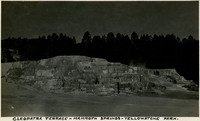 McCarthy Album 10, Photograph 146
McCarthy Album 10, Photograph 146 Caption: "Cleopatra Terrace - Mammoth Springs - Yellowstone Park," c. 1935.
-
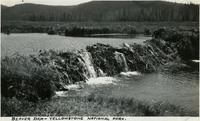 McCarthy Album 10, Photograph 145
McCarthy Album 10, Photograph 145 Caption: "Beaver Dam - Yellowstone National Park," c. 1935.
-
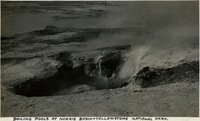 McCarthy Album 10, Photograph 144
McCarthy Album 10, Photograph 144 Caption: "Boiling Pools at Norris Basin - Yellowstone National Park," c. 1935.
-
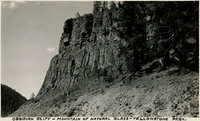 McCarthy Album 10, Photograph 143
McCarthy Album 10, Photograph 143 Caption: "Obsidian Cliff - Mountain of Natural Glass - Yellowstone Park," c. 1935.
-
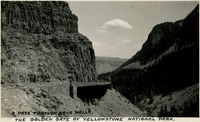 McCarthy Album 10, Photograph 142
McCarthy Album 10, Photograph 142 Caption: "A pass through lava walls. The Golden Gate of Yellowstone National Park," c. 1935.
-
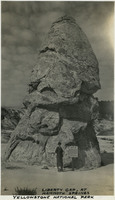 McCarthy Album 10, Photograph 141
McCarthy Album 10, Photograph 141 Caption: "Liberty Cap, at Mammoth Springs, Yellowstone National Park," c. 1935, shows Grace McCarthy standing in front of a towering travertine (limestone) rock, Liberty Cap, at Mammoth Springs, Yellowstone National Park.
-
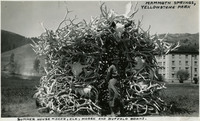 McCarthy Album 10, Photograph 140
McCarthy Album 10, Photograph 140 Caption: "Mammoth Springs, Yellowstone Park. Summer House - Deer, Elk, Moose and Buffalo horns," c. 1935, shows Grace McCarthy standing at the entrance to a hut made of many antlers, skulls, and bones from elk, deer, moose, and buffalo.
-
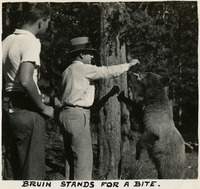 McCarthy Album 10, Photograph 139
McCarthy Album 10, Photograph 139 Caption: "Bruin stands for a bite," c. 1935, shows William McCarthy feeding a bear, while another man looks on.
-
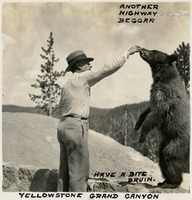 McCarthy Album 10, Photograph 138
McCarthy Album 10, Photograph 138 Caption: "Another Highway Beggar. Have a bite bruin. Yellowstone Grand Canyon," c. 1935.
-
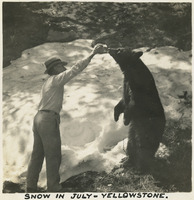 McCarthy Album 10, Photograph 137
McCarthy Album 10, Photograph 137 Caption: "Snow in July - Yellowstone," c. 1935, shows William McCarthy feeding a bear next to a pile of snow.
-
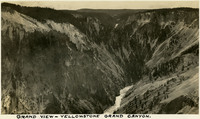 McCarthy Album 10, Photograph 136
McCarthy Album 10, Photograph 136 Caption: "Grand View - Yellowstone Grand Canyon," c. 1935.
-
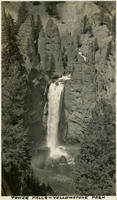 McCarthy Album 10, Photograph 135
McCarthy Album 10, Photograph 135 Caption: "Tower Falls - Yellowstone Park, " c. 1935.
-
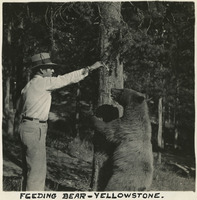 McCarthy Album 10, Photograph 134
McCarthy Album 10, Photograph 134 Caption: "Feeding Bear - Yellowstone," c. 1935, shows William McCarthy feeding a bear at Yellowstone National Park.
-
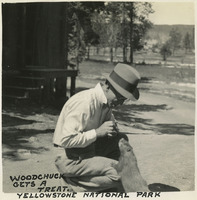 McCarthy Album 10, Photograph 133
McCarthy Album 10, Photograph 133 Caption: "Woodchuck gets a treat. Yellowstone National Park," c. 1935, shows William McCarthy feeding a woodchuck.
-
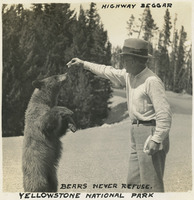 McCarthy Album 10, Photograph 132
McCarthy Album 10, Photograph 132 Caption: "Highway Beggar. Bears never refuse. Yellowstone National Park," c. 1935.
-
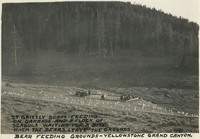 McCarthy Album 10, Photograph 131
McCarthy Album 10, Photograph 131 Caption: "29 Grizzly Bears feeding on garbage and a flock of seagulls [sic] waiting for a bite when the bears leave the grounds. Bear feeding grounds - Yellowstone Grand Canyon," c. 1935.
-
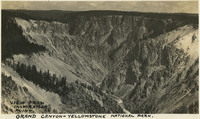 McCarthy Album 10, Photograph 130
McCarthy Album 10, Photograph 130 Caption: "View from Inspiration Point. Grand Canyon-Yellowstone National Park," c. 1935.
-
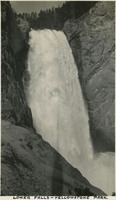 McCarthy Album 10, Photograph 129
McCarthy Album 10, Photograph 129 Caption: "Lower Falls - Yellowstone Park," c. 1935.
-
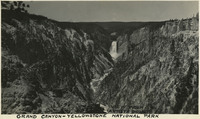 McCarthy Album 10, Photograph 128
McCarthy Album 10, Photograph 128 Caption: "Grand Canyon - Yellowstone National Park, view from artists' point," c. 1935.
-
 McCarthy Album 10, Photograph 127
McCarthy Album 10, Photograph 127 Caption: "Upper Falls -Yellowstone Grand Canyon," c. 1935.
-
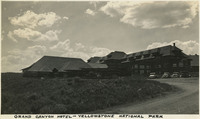 McCarthy Album 10, Photograph 126
McCarthy Album 10, Photograph 126 Caption: "Grand Canyon Hotel - Yellowstone National Park," c. 1935.
-
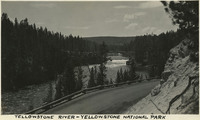 McCarthy Album 10, Photograph 125
McCarthy Album 10, Photograph 125 Caption: "Yellowstone River - Yellowstone National Park," c. 1935.
-
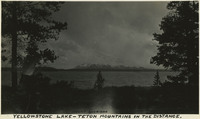 McCarthy Album 10, Photograph 124
McCarthy Album 10, Photograph 124 Caption: "Yellowstone Lake - Teton Mountains in the distance, Mount Sheridan," c. 1935.
-
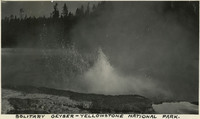 McCarthy Album 10, Photograph 123
McCarthy Album 10, Photograph 123 Caption: "Solitary Geyser-Yellowstone National Park," c. 1935.
-
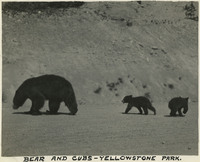 McCarthy Album 10, Photograph 122
McCarthy Album 10, Photograph 122 Caption: "Bear and Cubs - Yellowstone National Park," c. 1935.
-
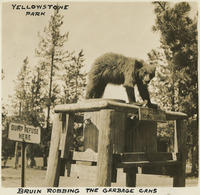 McCarthy Album 10, Photograph 121
McCarthy Album 10, Photograph 121 Caption: "Bruin robbing the garbage cans," c. 1935, shows a bear raiding garbage cans at Yellowstone National Park.
-
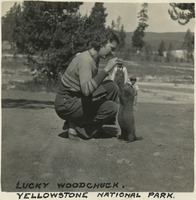 McCarthy Album 10, Photograph 120
McCarthy Album 10, Photograph 120 Caption: "Lucky Woodchuck, Yellowstone National Park," c. 1935. An unidentified woman seen feeding a woodchuck.
-
 McCarthy Album 10, Photograph 119
McCarthy Album 10, Photograph 119 Caption: "Feeding the Woodchuck - Yellowstone," c. 1935. William McCarthy feeding a woodchuck.
-
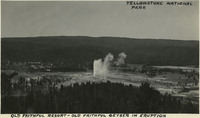 McCarthy Album 10, Photograph 118
McCarthy Album 10, Photograph 118 Caption: "Old Faithful Resort - Old Faithful Geyser in eruption, Yellowstone National Park" c. 1935.
-
 McCarthy Album 10, Photograph 117
McCarthy Album 10, Photograph 117 Caption: "Old Faithful Geyser in eruption," c. 1935.
-
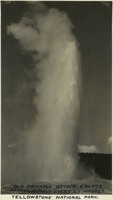 McCarthy Album 10, Photograph 116
McCarthy Album 10, Photograph 116 Caption: 'Old Faithful Geyser erupts approximately every 65 minutes. Yellowstone National Park," c. 1935.
-
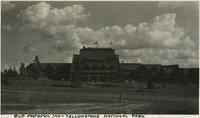 McCarthy Album 10, Photograph 115
McCarthy Album 10, Photograph 115 Caption: "Old Faithful Inn - Yellowstone National Park," c. 1935.
-
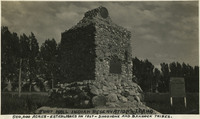 McCarthy Album 10, Photograph 114
McCarthy Album 10, Photograph 114 Caption: "Fort Hall Indian Reservation, Idaho. 500,000 acres - established in 1867 - Shoshone and Bannock Tribes," c. 1935.
 McCarthy Album 10, Photograph 163 Caption: "Two Medicine Lake and Rockwell Mountain - Glacier Park," c. 1935.
McCarthy Album 10, Photograph 163 Caption: "Two Medicine Lake and Rockwell Mountain - Glacier Park," c. 1935. McCarthy Album 10, Photograph 162 Caption: "Lewis Mountain Range - Glacier National Park," c. 1935.
McCarthy Album 10, Photograph 162 Caption: "Lewis Mountain Range - Glacier National Park," c. 1935. McCarthy Album 10, Photograph 161 Caption: "Going to the Sun Chalet - Glacier National Park," c. 1935.
McCarthy Album 10, Photograph 161 Caption: "Going to the Sun Chalet - Glacier National Park," c. 1935. McCarthy Album 10, Photograph 160 Caption: "Saint Mary's Lake and going to the Sun Mountain. Glacier National Park," c. 1935.
McCarthy Album 10, Photograph 160 Caption: "Saint Mary's Lake and going to the Sun Mountain. Glacier National Park," c. 1935. McCarthy Album 10, Photograph 159 Caption: "Steam shovel removing snow slide from highway. Logan Pass Summit - Glacier National Park," c. 1935.
McCarthy Album 10, Photograph 159 Caption: "Steam shovel removing snow slide from highway. Logan Pass Summit - Glacier National Park," c. 1935. McCarthy Album 10, Photograph 158 Caption: "Livingston Mountains - Glacier National Park," c. 1935.
McCarthy Album 10, Photograph 158 Caption: "Livingston Mountains - Glacier National Park," c. 1935. McCarthy Album 10, Photograph 157 Caption: "Mount Reynolds - Logan Pass - Glacier National Park," c. 1935.
McCarthy Album 10, Photograph 157 Caption: "Mount Reynolds - Logan Pass - Glacier National Park," c. 1935. McCarthy Album 10, Photograph 156 Caption: "Mount Clements - Logan Pass - Glacier National Park, Mrs. McC.," c. 1935, shows Grace McCarthy in the foreground holding a snowball.
McCarthy Album 10, Photograph 156 Caption: "Mount Clements - Logan Pass - Glacier National Park, Mrs. McC.," c. 1935, shows Grace McCarthy in the foreground holding a snowball. McCarthy Album 10, Photograph 155 Caption: "Livingston Mountains - Glacier National Park," c. 1935.
McCarthy Album 10, Photograph 155 Caption: "Livingston Mountains - Glacier National Park," c. 1935. McCarthy Album 10, Photograph 154 Caption: "Lake McDonald - Glacier National Park," c. 1935.
McCarthy Album 10, Photograph 154 Caption: "Lake McDonald - Glacier National Park," c. 1935. McCarthy Album 10, Photograph 153 Caption: "State capitol building - Helena, Montana. Helena, Population 12,000," c. 1935.
McCarthy Album 10, Photograph 153 Caption: "State capitol building - Helena, Montana. Helena, Population 12,000," c. 1935. McCarthy Album 10, Photograph 152 Caption: "Great Divide. Summit near Butte Montana," c. 1935.
McCarthy Album 10, Photograph 152 Caption: "Great Divide. Summit near Butte Montana," c. 1935. McCarthy Album 10, Photograph 151 Caption: "Butte, Montana. In miner's suits after a 3,000 foot descent in the cage of Leonard Mine - Anaconda Copper Mining Co.," c. 1935, shows William and Grace McCarthy in miner's suits and helmets.
McCarthy Album 10, Photograph 151 Caption: "Butte, Montana. In miner's suits after a 3,000 foot descent in the cage of Leonard Mine - Anaconda Copper Mining Co.," c. 1935, shows William and Grace McCarthy in miner's suits and helmets. McCarthy Album 10, Photograph 150 Caption: "Butte, population 40,000. The city of Butte is honeycombed underneath by numerous copper mines. The mining section, Butte, Mo. one mile high & one mile deep," c. 1935.
McCarthy Album 10, Photograph 150 Caption: "Butte, population 40,000. The city of Butte is honeycombed underneath by numerous copper mines. The mining section, Butte, Mo. one mile high & one mile deep," c. 1935. McCarthy Album 10, Photograph 149 Caption: "View from Jupiter Terrace, of Park headquarters. Mammoth Hot Springs - Yellowstone National Park," c. 1935.
McCarthy Album 10, Photograph 149 Caption: "View from Jupiter Terrace, of Park headquarters. Mammoth Hot Springs - Yellowstone National Park," c. 1935. McCarthy Album 10, Photograph 148 Caption: "Jupiter Terrace - Mammoth Springs -Yellowstone Park," c. 1935.
McCarthy Album 10, Photograph 148 Caption: "Jupiter Terrace - Mammoth Springs -Yellowstone Park," c. 1935. McCarthy Album 10, Photograph 147 Caption: "Angel Terrace, Mammoth Springs - Yellowstone Park," c. 1935, shows William McCarthy standing near the travertine (limestone) terrace.
McCarthy Album 10, Photograph 147 Caption: "Angel Terrace, Mammoth Springs - Yellowstone Park," c. 1935, shows William McCarthy standing near the travertine (limestone) terrace. McCarthy Album 10, Photograph 146 Caption: "Cleopatra Terrace - Mammoth Springs - Yellowstone Park," c. 1935.
McCarthy Album 10, Photograph 146 Caption: "Cleopatra Terrace - Mammoth Springs - Yellowstone Park," c. 1935. McCarthy Album 10, Photograph 145 Caption: "Beaver Dam - Yellowstone National Park," c. 1935.
McCarthy Album 10, Photograph 145 Caption: "Beaver Dam - Yellowstone National Park," c. 1935. McCarthy Album 10, Photograph 144 Caption: "Boiling Pools at Norris Basin - Yellowstone National Park," c. 1935.
McCarthy Album 10, Photograph 144 Caption: "Boiling Pools at Norris Basin - Yellowstone National Park," c. 1935. McCarthy Album 10, Photograph 143 Caption: "Obsidian Cliff - Mountain of Natural Glass - Yellowstone Park," c. 1935.
McCarthy Album 10, Photograph 143 Caption: "Obsidian Cliff - Mountain of Natural Glass - Yellowstone Park," c. 1935. McCarthy Album 10, Photograph 142 Caption: "A pass through lava walls. The Golden Gate of Yellowstone National Park," c. 1935.
McCarthy Album 10, Photograph 142 Caption: "A pass through lava walls. The Golden Gate of Yellowstone National Park," c. 1935. McCarthy Album 10, Photograph 141 Caption: "Liberty Cap, at Mammoth Springs, Yellowstone National Park," c. 1935, shows Grace McCarthy standing in front of a towering travertine (limestone) rock, Liberty Cap, at Mammoth Springs, Yellowstone National Park.
McCarthy Album 10, Photograph 141 Caption: "Liberty Cap, at Mammoth Springs, Yellowstone National Park," c. 1935, shows Grace McCarthy standing in front of a towering travertine (limestone) rock, Liberty Cap, at Mammoth Springs, Yellowstone National Park. McCarthy Album 10, Photograph 140 Caption: "Mammoth Springs, Yellowstone Park. Summer House - Deer, Elk, Moose and Buffalo horns," c. 1935, shows Grace McCarthy standing at the entrance to a hut made of many antlers, skulls, and bones from elk, deer, moose, and buffalo.
McCarthy Album 10, Photograph 140 Caption: "Mammoth Springs, Yellowstone Park. Summer House - Deer, Elk, Moose and Buffalo horns," c. 1935, shows Grace McCarthy standing at the entrance to a hut made of many antlers, skulls, and bones from elk, deer, moose, and buffalo. McCarthy Album 10, Photograph 139 Caption: "Bruin stands for a bite," c. 1935, shows William McCarthy feeding a bear, while another man looks on.
McCarthy Album 10, Photograph 139 Caption: "Bruin stands for a bite," c. 1935, shows William McCarthy feeding a bear, while another man looks on. McCarthy Album 10, Photograph 138 Caption: "Another Highway Beggar. Have a bite bruin. Yellowstone Grand Canyon," c. 1935.
McCarthy Album 10, Photograph 138 Caption: "Another Highway Beggar. Have a bite bruin. Yellowstone Grand Canyon," c. 1935. McCarthy Album 10, Photograph 137 Caption: "Snow in July - Yellowstone," c. 1935, shows William McCarthy feeding a bear next to a pile of snow.
McCarthy Album 10, Photograph 137 Caption: "Snow in July - Yellowstone," c. 1935, shows William McCarthy feeding a bear next to a pile of snow. McCarthy Album 10, Photograph 136 Caption: "Grand View - Yellowstone Grand Canyon," c. 1935.
McCarthy Album 10, Photograph 136 Caption: "Grand View - Yellowstone Grand Canyon," c. 1935. McCarthy Album 10, Photograph 135 Caption: "Tower Falls - Yellowstone Park, " c. 1935.
McCarthy Album 10, Photograph 135 Caption: "Tower Falls - Yellowstone Park, " c. 1935. McCarthy Album 10, Photograph 134 Caption: "Feeding Bear - Yellowstone," c. 1935, shows William McCarthy feeding a bear at Yellowstone National Park.
McCarthy Album 10, Photograph 134 Caption: "Feeding Bear - Yellowstone," c. 1935, shows William McCarthy feeding a bear at Yellowstone National Park. McCarthy Album 10, Photograph 133 Caption: "Woodchuck gets a treat. Yellowstone National Park," c. 1935, shows William McCarthy feeding a woodchuck.
McCarthy Album 10, Photograph 133 Caption: "Woodchuck gets a treat. Yellowstone National Park," c. 1935, shows William McCarthy feeding a woodchuck. McCarthy Album 10, Photograph 132 Caption: "Highway Beggar. Bears never refuse. Yellowstone National Park," c. 1935.
McCarthy Album 10, Photograph 132 Caption: "Highway Beggar. Bears never refuse. Yellowstone National Park," c. 1935. McCarthy Album 10, Photograph 131 Caption: "29 Grizzly Bears feeding on garbage and a flock of seagulls [sic] waiting for a bite when the bears leave the grounds. Bear feeding grounds - Yellowstone Grand Canyon," c. 1935.
McCarthy Album 10, Photograph 131 Caption: "29 Grizzly Bears feeding on garbage and a flock of seagulls [sic] waiting for a bite when the bears leave the grounds. Bear feeding grounds - Yellowstone Grand Canyon," c. 1935. McCarthy Album 10, Photograph 130 Caption: "View from Inspiration Point. Grand Canyon-Yellowstone National Park," c. 1935.
McCarthy Album 10, Photograph 130 Caption: "View from Inspiration Point. Grand Canyon-Yellowstone National Park," c. 1935. McCarthy Album 10, Photograph 129 Caption: "Lower Falls - Yellowstone Park," c. 1935.
McCarthy Album 10, Photograph 129 Caption: "Lower Falls - Yellowstone Park," c. 1935. McCarthy Album 10, Photograph 128 Caption: "Grand Canyon - Yellowstone National Park, view from artists' point," c. 1935.
McCarthy Album 10, Photograph 128 Caption: "Grand Canyon - Yellowstone National Park, view from artists' point," c. 1935. McCarthy Album 10, Photograph 127 Caption: "Upper Falls -Yellowstone Grand Canyon," c. 1935.
McCarthy Album 10, Photograph 127 Caption: "Upper Falls -Yellowstone Grand Canyon," c. 1935. McCarthy Album 10, Photograph 126 Caption: "Grand Canyon Hotel - Yellowstone National Park," c. 1935.
McCarthy Album 10, Photograph 126 Caption: "Grand Canyon Hotel - Yellowstone National Park," c. 1935. McCarthy Album 10, Photograph 125 Caption: "Yellowstone River - Yellowstone National Park," c. 1935.
McCarthy Album 10, Photograph 125 Caption: "Yellowstone River - Yellowstone National Park," c. 1935. McCarthy Album 10, Photograph 124 Caption: "Yellowstone Lake - Teton Mountains in the distance, Mount Sheridan," c. 1935.
McCarthy Album 10, Photograph 124 Caption: "Yellowstone Lake - Teton Mountains in the distance, Mount Sheridan," c. 1935. McCarthy Album 10, Photograph 123 Caption: "Solitary Geyser-Yellowstone National Park," c. 1935.
McCarthy Album 10, Photograph 123 Caption: "Solitary Geyser-Yellowstone National Park," c. 1935. McCarthy Album 10, Photograph 122 Caption: "Bear and Cubs - Yellowstone National Park," c. 1935.
McCarthy Album 10, Photograph 122 Caption: "Bear and Cubs - Yellowstone National Park," c. 1935. McCarthy Album 10, Photograph 121 Caption: "Bruin robbing the garbage cans," c. 1935, shows a bear raiding garbage cans at Yellowstone National Park.
McCarthy Album 10, Photograph 121 Caption: "Bruin robbing the garbage cans," c. 1935, shows a bear raiding garbage cans at Yellowstone National Park. McCarthy Album 10, Photograph 120 Caption: "Lucky Woodchuck, Yellowstone National Park," c. 1935. An unidentified woman seen feeding a woodchuck.
McCarthy Album 10, Photograph 120 Caption: "Lucky Woodchuck, Yellowstone National Park," c. 1935. An unidentified woman seen feeding a woodchuck. McCarthy Album 10, Photograph 119 Caption: "Feeding the Woodchuck - Yellowstone," c. 1935. William McCarthy feeding a woodchuck.
McCarthy Album 10, Photograph 119 Caption: "Feeding the Woodchuck - Yellowstone," c. 1935. William McCarthy feeding a woodchuck. McCarthy Album 10, Photograph 118 Caption: "Old Faithful Resort - Old Faithful Geyser in eruption, Yellowstone National Park" c. 1935.
McCarthy Album 10, Photograph 118 Caption: "Old Faithful Resort - Old Faithful Geyser in eruption, Yellowstone National Park" c. 1935. McCarthy Album 10, Photograph 117 Caption: "Old Faithful Geyser in eruption," c. 1935.
McCarthy Album 10, Photograph 117 Caption: "Old Faithful Geyser in eruption," c. 1935. McCarthy Album 10, Photograph 116 Caption: 'Old Faithful Geyser erupts approximately every 65 minutes. Yellowstone National Park," c. 1935.
McCarthy Album 10, Photograph 116 Caption: 'Old Faithful Geyser erupts approximately every 65 minutes. Yellowstone National Park," c. 1935. McCarthy Album 10, Photograph 115 Caption: "Old Faithful Inn - Yellowstone National Park," c. 1935.
McCarthy Album 10, Photograph 115 Caption: "Old Faithful Inn - Yellowstone National Park," c. 1935. McCarthy Album 10, Photograph 114 Caption: "Fort Hall Indian Reservation, Idaho. 500,000 acres - established in 1867 - Shoshone and Bannock Tribes," c. 1935.
McCarthy Album 10, Photograph 114 Caption: "Fort Hall Indian Reservation, Idaho. 500,000 acres - established in 1867 - Shoshone and Bannock Tribes," c. 1935.